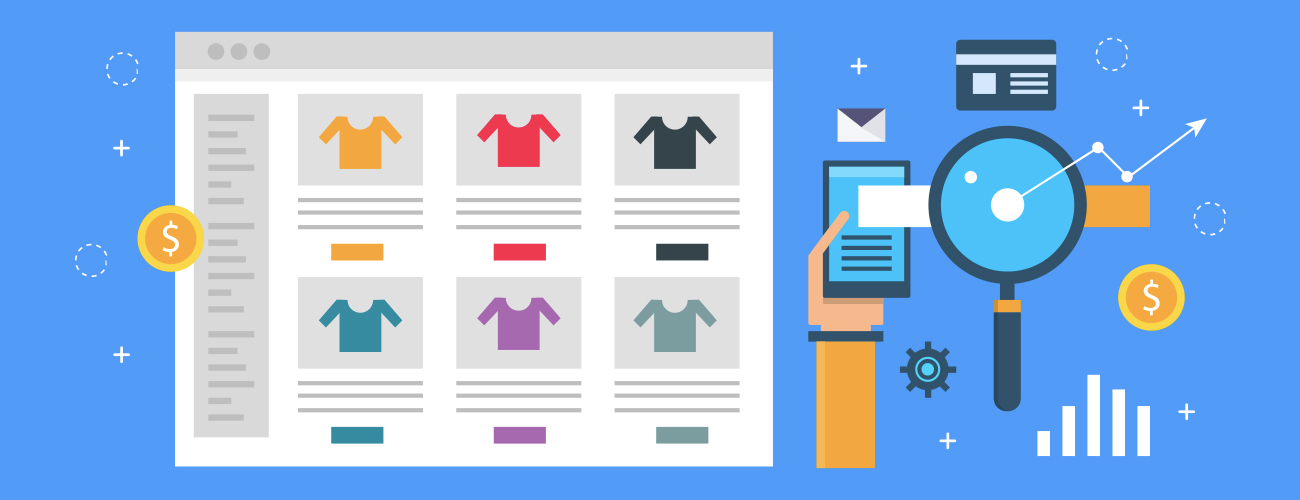eCommerce is the abbreviation of electronic commerce. It is a type of business that involves buying and selling goods and services. The sales transactions are done via the internet. An eCommerce website is nothing but an online store that facilitates any kind of business or commercial transactions. This also promotes the transfer of data and information. The purpose of any eCommerce website is to move a step ahead than just the promotion of a company’s product or service.
As per research, currently, there are approximately 12 million – 24 million eCommerce sites worldwide. The count just keeps multiplying with each new day. A major reason for the rapid growth of eCommerce websites is an easy way to make money online.
What is an eCommerce Website?
Ecommerce websites branch out into variants based on two essential parameters; type of offerings on sale and nature of the participants. Moreover, you can segment the types of offerings by an eCommerce website based on the business model of an organization. These segments include; Digital products (eBooks, Software, Music, Online Streaming Service), Physical Products (Apparel, Footwear, Home Décor, Grocery), and Services (Insurance, E-wallet, E-tickets, Bookings). On the other hand, the nature of the participants (businessmen, government, consumers) depends on the type of eCommerce business. This can be classified into:


- Business to business (B2B)
- Business to consumer (B2C)
- Consumer to business (C2B)
- Consumer to consumer (C2C)
- Business to administration (B2A)
- Consumer to administration (C2A)
E-Business vs eCommerce
The advancement of technology has taken a leap. As a result, one finds it difficult to understand whether the business is an eCommerce or eBusiness. Therefore, to understand better the below classification of activities will resolve this complex understanding:
E-Business
E-business includes Email Marketing to existing and/or prospective customers. Moreover, tracking of an inventory and alerts are at specific levels. The content management system that manages the workflow between a content developer, editor, manager, and publisher. Online tools for human resources that include online job boards, application processers, and systems to maintain employee data
You can handle an e-business in-house through a company network. Alternatively, you can also outsource it sometimes. While considering the contrast between a standard business and an e-business, one needs to look for the manner in which a business is conducted. In short, advising the customer through human assistance is standard business. On the other hand, if there is a website that helps its customers or users to understand and compare the variety of products available, then this can be termed as eBusiness. Now that you understand eBusiness, let us dive deep into how eCommerce is different from eBusiness.
E-Commerce
As stated at the beginning of this article, eCommerce is the involvement of buying and selling of goods and services and the sales transaction done via the internet. An eCommerce platform can include every procedure of customer sales; right from ordering a product to making a payment to its delivery at the customer’s doorstep.
An eCommerce business can at times involve just one part of the customer sales as well. Some eCommerce websites allow payment activity over the internet directly through the sharing of payment details. However, sometimes, the payment may also be carried at a store from which the customer requests a pickup.
At times, the business might involve third party delivery carriers. As a result, you can do the payment of the sale at the time of delivery. However, the payment proceeds, the transaction still involves a component of e-commerce.
Apart from their own eCommerce websites, businesses choose to sell via different marketplaces. You can do this to reach a wider audience and ensure faster delivery. For example, brands like Lakme, Maybelline, L`Oreal Paris,, Lotus Herbals, Dove may have their own eCommerce websites for customers to purchase from.
They also expand their horizon by selling over an online retailer like Nykaa. Whether a customer purchases from the brand’s website or via Nykaa, the mode of transaction is still involved under the broader aspect of eCommerce.
Difference between Regular Business Website and eCommerce Website


Any online business needs a landing page to provide information to its users. Both an eCommerce website or a regular business website share functional similarities such as internet connectivity, etc. However, some differences need to be penned down to understand the purpose of creating a website for your company.
A Wire-frame for your eCommerce Website
Website designing is not as easy as it seems to be. It’s a complex process. However, free website builder tools help ease the process. From the above table, one can surely tell that designing an eCommerce website is surely a challenge. The major reason being, it is customed for users to shop. User-friendly design and easy navigation are the two major pillars to attract customers. Without this, there is surely no traffic.
Let us understand the various guidelines and design ideas needed for an eCommerce website.
Define your website based on the products
As a business owner, one of the main concepts to keep in mind is consistency. You are aware of the products you are going to sell. Now match your design with the products. Ensure that the color scheme, the look and feel, the images used, and the content complement each other. Use the right theme and template


Informed Product Description and Image
Apart from a regular homepage design that provides information about your company and products, the ultimate reason for an eCommerce business is to sell. Your product is the hero. Highlight the products and it should stand out from the other information on your website. Use high-quality images to personify your product, thus making it look more realistic. A detailed product description backed with an image completes the product information. This will keep the customers engaged to make the right purchase decision.
Cost of Shipping
A shipping cost is something a customer looks out for. The purchase is a good-deal only when the shipping cost incurred is lower than the product cost or even better if free. Ensure that the customers do not feel that they could have chosen a regular store over your eCommerce business because of the shipping cost. This also allows you to build a competitive edge.
Your E-cart Design


An E-cart has multiple roles to play in an eCommerce website. Fairly, the most crucial one too. These roles include adding multiple products, revising an order, or removing unwanted products. The design of the E-cart should consist of operative product images, a review section, an easy navigation search bar.
Prospect Checkout
As an eCommerce website, it is ideal for you to ensure that users register and create an account. This helps to generate leads and find potential prospects. However, anonymous checkouts allow guest users with a quick product purchase. Do not force users to provide unnecessary personal details. You may lose customers even before a buy.
User-Friendly Checkout
The easier the checkout process, the faster the sales. The one-page checkout process is ideal. The greater number of pages, the lesser customer information you will receive. When your website checkout process is given a human touch as it would be in a physical store, the customer gains its trust. This ensures re-purchases and re-orders.
Payment Gateways
When choosing a payment option for your eCommerce website, keep in mind your target audience. Use a generalized mode of payment. Payment wallets like Google pay and Paytm are widely used in the country. If international, PayPal should be considered. Apart from this, Credit/debit card options or bank transfers will help customers to choose the best medium. Do not restrict to one particular payment medium. Having said this, ensure your payment gateways are trusted, secure, and free of glitches.
Customer Support and Company Information


Customers tend to seek help if stuck while making an online purchase. Giving a human touch to your eCommerce website by providing responsive customer support details builds relationships. As an eCommerce business, you need to show the customers that you are happy to solve their queries. These can be done in various ways, such as a toll-free number, and email address, or live chatbots. Ensure that all the information is correct and functioning right.
Apart from the above points, ensure that the eCommerce website is secure and is backed by social proofs. This includes order confirmation emails, tracking updates in real-time, and customer follow-ups.
“Create wow moments for your prospects and watch your online sentiment increase.”
― Stacey Kehoe
How to build an ecommerce website
An eCommerce website can be built in two ways. The first way is to get is designed and developed by a professional web developer while the second way is to use a free eCommerce website builder. Building a website depends on mainly two factors; the budget plan and the time needed for an eCommerce website to get started. Let us look at the step-by-step guide of creating a website using a website builder such as Shopify, WooCommerce, Woozone.
Shopify
Shopping to shipping is a complete lifecycle of the e-commerce business. Shopify aims to provide the best business solutions to its partners across the globe. The Shopify bundle is a one-stop solution required by any business to excel.
The step-by-step guide will help an online seller to set up their store, integrate the payments, managing shipments, and growing their business from home.


Start by creating a domain and choosing a theme.
Choosing the right domain name is one of the most important aspects of any eCommerce website. Your domain name will not only communicate with your users but also to various search engines. With the right implementation of SEO, your domain name can drive traffic to your website while providing correct information. While choosing a domain name, consider these points:
- Use as much reliable keywords, however don’t clutter with keywrods
- Ensure that your domain name is unique and not used by another website
- Concise, Creative and Easy to pronounce domain names are ones to choose from
- Consider your Top Level Domain Name (.com, .org, .in)
Choose a Professional Theme
Shopify has over 70 professionally designed themes available to choose from. The drag and drop store builder option helps to customize the theme for background, font, and alignment. It is estimated that almost 10 million businesses are powered through the optimized platform. There are many features which makes the platform a comprehensive business solution, namely:
- Professionally designed mobile and PC customized themes
- Comprehensive dashboard for detailed analysis
- Automated marketing and in-built SEO features
- Secured and Encrypted Shopify payments option through multiple mediums
- Exhaustive apps synced to the online store for expansion
- Quick and interactive help guide
Adding the products to the store
Once the store is set, a seller can add his/her products. On selecting the ‘Product option’ in the navigation, the seller can ‘Add Product one by one’. It is necessary to ensure that the product image is attractive and clear. SEO tags for one’s product will help rank it to the top. Categorization of these products is also available, and one can either perform this function manually or using the automated function.
Inventory management is easy and convenient for Shopify. It helps to track the quantity stocked, notify if ‘out of stock’, product organization based on filters, and variants.
Integrating Multiple Apps to Grow Business
Managing and growing the business is a tedious process. The integration of apps can help in better management and sales. One can even choose to sell via apps like Oberlo on Shopify. Oberlo has a huge inventory with thousands of products that can be directly added to your store. All that an owner needs to do is manage the store and handle it. Shopify has its expertise in dropshipping, hence one doesn’t have to worry about maintaining a warehouse or inventory at home. One can resell via Oberlo, as it looks after packaging, shipping, and delivery of the product, all in one.
Safe and secured shopping cart and payment
Online payments are risky if not secure. Hence Shopify payments are protected through a 256-bit SSL certification aimed at protecting credit card and transaction information. With the integration of over 100 payment gateways, it is convenient for global transactions. The online store checkout is available in 50+ languages, which makes it convenient for a diverse audience. The shipping rates too are flexible, and all the taxes are country-based.
Ease of Store Management
The luxury of an online store is the ‘ease of management’ through a laptop at your comfort. The user-friendly dashboard helps in better management as it gives insight about sales, customers, order fulfillment, managing refunds, or completion of an order. The integration of dropshipping through various apps is a great way to fuel business. The Shopify app conveniently helps in managing the store at the go anywhere, anytime.
Understanding the analytics for traffic
The success of an online store is determined through traffic and its outreach. The traffic and sales can be easily analyzed using Google analytic integration. This feature gives in detailed information about sales, orders, and the incoming traffic to your business and store. The product reports analyze the growth of the store while the export reports can be checked to create accountability. With the help of Google analytics, it has become easy to monitor and keep track of the store’s progress.
Get Easy and Instant Expert Help
The best part of setting up an online store is the instant help from a dedicated support team. The approved e-commerce designers or marketers help in customizing the store to boost up sales and revenue. The support team is available 24 hours a day through email, phone, or live chat to assist customers. Be it with Shopify payments or online store management, there are assistance and guidance provided.
Shopify, helps to kick-start your business and earn at the comfort of your home.
WooCommerce
WooCommerce Plugin provides the perfect solution. It assists in transforming a normal WordPress internet site into an online eCommerce shop.
WooCommerce is a WordPress eCommerce plugin. It is open-source. It is popular among eCommerce store owners due to its features. Some of which include various shipping and settlement approaches, variable items, and more. Many large- and small companies have started utilizing WooCommerce on a broad scale.
Now let’s take a look at how to install WooCommerce on your WordPress site.
Step by Step Guide to Setting Up Your WooCommerce Store
Setting Up and Installing WooCommerce
WooCommerce is a free plugin for WordPress. It can be downloaded from the official directory site of WordPress plugins. To begin the download process, you will have to log in to your admin WordPress account.
- To start installing WooCommerce, follow the steps mentioned below-
- Go to the WordPress dashboard. From the left side menu, choose Plugins.
- Click on Add New. In the search bar, type WooCommerce.
- In the search results page, find WooCommerce and click on Install now.
- As soon as the setup is full, click on the button Activate.
- A welcome message will be the first thing you see from WooCommerce. Click on the purple button to run the setup wizard.
WooCommerce Wizard
Alternatively, you can also use the WooCommerce wizard’s help -> Help -> Configuration Wizard section. The following points below give all the details regarding the setup process:
- Set the nation, currency, address, and also the type of products you intend to sell.
- Click ‘Let’s Go’ as soon as you are done!
- Select from the various repayment methods for your shop. A couple of alternatives include —Stripe, PayPal, and different offline payments.
- Set up the shipping details for different regions — local and worldwide.
- Thereafter, set the delivery limit you plan on spending (a level price or cost-free delivery).
- Next is setting the preferred unit of the dimension. It also gives the option of various carrier services. The extensions of services like FedEx and UPS are provided.
Setting Up Extensions
WooCommerce will ask you to allow four of the most popular extensions. These are-
- Facebook combination
- Automated Texas
- MailChimp
- WooCommerce Admin
The next step is to link your shop with Jetpack. Jetpack additionally offers more advantages. They include better safety along with shop monitoring. This feature provides the promotion of items, and the capability to see the store statistics in detail.
To develop an account in Jetpack by providing your email address, username, as well as password. After authorizing, you will relocate to the last section of the installation procedure.
Importing Items
If you have created a CSV file consisting of the name of your items, select Import products. Alternatively, click ‘Create an item’. This will permit you to start adding items.
Item Classification
This helps classify your products. If you want to sell clothes, ‘top-wear,’ ‘bottom wear,’ as well as ‘nightwear’ are item categories. These items allow the customer to find items from the identical classification. Moreover, you can develop as many collections as you require and modify them anytime.


Qualities
This helps filter the items either by size, fabric, color, or merchandise. It also depends on the searches of the customers. It assists them in choosing their preferred items.
Product Types
Predefined item types are inbuilt within WooCommerce. It helps you to save your time. The item types are:
- Simple – An isolated item that is delivered without other additional selections. Such as a physical book.
- Grouped – Connected items can be grouped, such as drinking glasses
- Digital – these are items that need no shipping. It is because they do not count as physical entities. It includes solutions.
- Downloadable – electronic products that can be downloaded, like Songs, videos, images, e-books.
- External – Some products are promoted on the website. But they are sold in a different store. It consists of those items.
- Variable – Products that have variable standards and qualities. The top attributes might be sizes, shoes, garments, and colors.
Adding Your Items to WooCommerce
With several item options, it might become confusing to add your items to WooCommerce. Do not stress.
You can simply follow the steps below-
- From the WordPress control panel, navigate to Products. Then go to Create Product.
- Alternatively, float on Products. Then click on Add New.
- Enter your item’s name and also include a full description. Guarantee that it consists
- of relevant information regarding your product.
- Scroll to the section Product information. Then select the product kind. Establish extra information– expense, supply and supply, shipping, connected products, and so on.
- To add a summary, navigate to the end of the page. Here, you can provide a summary to be shown listed under the product’s name.
- Add the item classifications, tags, and a highlighted image. You may include product gallery pictures as well. These controls correspond to the controls required for a WordPress article.
- The only distinction is the Directory direct exposure alternative which has these options:
- Search engine results: The items gains visibility throughout the search results, categories, and other pages of the eCommerce store.
- Shop or Internet search engine results only: All products will appear only on the store as well as category web pages or on the search results page.
- The items appears exclusively on the individual item page. They will certainly not be readily available on other web pages.
As soon as you are more than satisfied with the defined settings, check the Preview and then press Publish.
Handling Products
Let’s take a look at how WooCommerce will handle your products.
- Replicating a product: Each product has a duplicate button. WooCommerce will produce and start a brand-new item draft for modification.
- Marking an item as featured: Ensure that the Star symbol is clicked on the items of your homepage, thus the display of the featured items. Another way of display is through various posts by utilizing short-codes.
- Deleting a product. Make certain that the Bin button is clicked. It comes beneath the item name as you float over it.
Woozone
Affiliate marketing is the new upgrade in modern marketing services. The influencers and experts in their fields enjoy a huge fan following, can make it big with affiliate marketing.
They have to handpick their preferred products in the category of their expertise. The next thing to do is to create a web store of their own using a plugin.
Homemakers and students looking to earn some extra income by putting minimal efforts should try using WooZone.
This becomes a great business model for entrepreneurs who aspire to run their business online. Affiliate marketing is also beneficial for customers to learn and gain knowledge from the learned in their respective fields.


Managing your eCommerce Website
Your eCommerce website is up and ready. But before you launch it, consider these few points. Ensure you have eliminated all the don’ts and have incorporated all the must-haves for your eCommerce website.


This will make certain that your website can generate more leads, thus impacting the sales revenue you attain to look at.
Simple yet Informative
The first thing to observe is if your homepage is free of clutter. Simple designs have better conversion rates in most cases. The focus of your homepage should be the CTA button, make sure that the information on the homepage drives a user to the CTA click. A website that has too much clutter will make it difficult to find the CTA, thus losing customers.
SEO Friendly Landing Pages
When a landing page is SEO friendly, you are sure to drive a lot of traffic to your eCommerce website. Ensure the right strategy and take the right expertise. Investing in an SEO practice will help your eCommerce website to rank amongst the top five in the Search Engine Results Pages: A bonus would be social media campaigns to increase your online visibility.
Online Advertising
Online advertising is definitely an investment, but the return on investment is surely double. But the thing to keep in mind is using the right technique to implement the advertising strategy. For this, the three things to keep in mind; Strong research, campaign management, and improvement of the landing page.
Target Your Niche
An eCommerce website is a marketplace where buying and selling take place. With the wide range of products available under one roof, it will be difficult to target the niche. Know your best sellers and prioritize your ad campaigns.

Choosing The Right Web Hosting Provider
A Web hosting provider makes available various technologies and services required to be seen on the internet. Use these points as guidance to select the best-preferred web hosting provider:
- Affordable and Reliable Pricing Plan
- Features Complement your eCommerce Website Needs
- Responsive Technical Support
- Availability of add-on features
- Good Quality Servers and Hardware used by the Provider
- Positive Customer Reviews and Experiences
- Various E-mail feature provision
- Easy Control Panel and User Interface
- Upgrades and Transfer Specifications
Dash101 is not just a shipping partner, but a business partner. With a well-organized network and years of experience, it can make a shipping process efficient and smooth. Dash101 ticks each of these boxes right.
With a pan-India delivery network covering 26,000 pin codes, it guarantees remote product reach. Dash101 also offers integration with platforms like Shopify to simplify order fulfillment.






[…] and digital product business owners have gone digital, and for every eCommerce business, an eCommerce website is a key […]
[…] as WZone, makes the job of e-commerce website owners easy and hassle-free. In spite of the multiple renditions Amazon keeps on making from […]
[…] it doesn’t have to be that way. Welcome, WooCommerce- your ultimate solution to building eCommerce website and start selling online in […]
[…] This team would look after building the eCommerce website, maintaining your mobile app and any backend ERPs you would be implementing in the […]
[…] strategy and reach out to your customers. Shopify is one such platform that helps you build your eCommerce website and excel with online […]
[…] E-Commerce website is nothing but an online portal that enables online transactions in exchange for products and […]